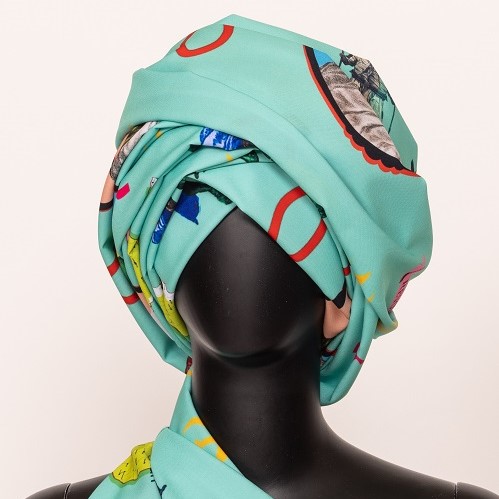Alternative Museum of The Sudan: Exhibition of work by Amado Alfadni, curated by Najlaa El-Ageli, at the Sulger-Buel Gallery in London Following our ‘Dialogues on the Art of Arab Fashion’ webinar episode on 16 June, our guest, Egyptian-Sudanese artist Amado Alfadni spoke to art and culture advisor Sophie Kazan shedding more light on aspects of this fascinating exhibition, presented here in the first of a three-part series.
screenshot from the webinar: Amado Alfadni with the Mahdi Jubba robe and custom-designed turban
Amado, you created a turban to go with an antique Jubba robe in the Zay
Zay: (Arabic: costume, Pl. azyaā’), a set of clothes in a style typical of a particular country or historical period. collection that was worn by the actor, Sir Laurence Olivier in the film Al Khartoum. Olivier’s role is of a Mahdi and you redesigned his turban or amama
‘amāma: (Arabic: turban, synonym: ‘immah, ‘imāmah, ‘amāmah), length of 6m long light weight fabric wrapped in turban form, worn in varying styles by men across the Arab world.. How did this project come about and was much research involved?
Yes. Since I saw
Al Khartoum as a kid on television in Egypt, I was disappointed at their representation of Sudan – it was filmed in an Egyptian village with Egyptian actors, and no Sudanese actor was involved.
Four Feathers was filmed in Morocco. It was different to what I knew to be true and for me, it raised more questions than it answered. It made me feel that representations of Sudan, in the US and Europe, could be different to reality.
When I had finished the Askari project and my research on slavery and textile, my mind was on the idea of re-presenting facts as they are and setting the story straight. In the film, there are so many misrepresentations – not least how Gordon Pasha was killed. In the film, it is a spear wound… [This ties in with the ethnic and underdeveloped image of Africa] … whereas in reality, it was a gunshot. You see that fake facts and images have become a reality. I felt the need to make this right and so, Dr Reem Al Mutwalli’s suggestion that I should use the Askari fabrics to re-design the headdress of the Mahdi’s robe that was in the collection, came at a good time.
The Jubba robe (
ZI2019.500740 SUDAN
) and turban (
ZI2022.500944 SUDAN
) is part of The
Zay
Zay: (Arabic: costume, Pl. azyaā’), a set of clothes in a style typical of a particular country or historical period. Collection.
How do you feel about the redressing of the colonial narrative in this way?
I feel it is important and at the moment there is a great questioning of history in the region generally, looking at how Egypt was represented and represented itself before and how history was informed or misinformed. I should say that there is also a need in Sudan and Egypt that is being felt to discover ‘the other’ and to break down the prejudices that existed previously. There has been a great denial of slavery everywhere and I am not just talking about people who took slaves in Europe, the Arab world, and Africa, but from the point of view of those who were slaves. There is a need to re-tell the story and to be creative about the media, in order for people to listen.
The
Mahdi Jubba Turban and the
Jubba robe, now part of The
Zay
Zay: (Arabic: costume, Pl. azyaā’), a set of clothes in a style typical of a particular country or historical period. Collection, can be viewed in our digital archive. In the second part of this series, Sophie will continue her conversation with Amado Alfadni, discussing The Askari Project. In the third part of this series, Sophie continues her conversation with Amado Alfadni, discussing Kantakas and Bint Al Sudan.
***
Read the second part,
Amado Alfadni: The Askari Project, here.
Read the third part,
Amado Alfadni: Kantakas and Bint Al Sudan here
.About the Author
Sophie Kazan fell in love with Islamic Art and decoration after visiting the Louvre in Paris. She studied History of Art at L’Ecole du Louvre, and has a BA (Hons) in Art and Archaeology of Asia and Africa from SOAS (University of London). Sophie completed her Master's in History of Art from the University of Oxford and a PhD from the School of Museum Studies, University of Leicester. Her research focused on the development of contemporary art and tradition in the United Arab Emirates. Sophie writes about visual art, and she lectures on critical theories and the history of architecture at the University of Falmouth, Cornwall.
Learn more about Sophie’s work on
her website and
Instagram profile.
The turban designed by Amado Alfadni for The
Zay
Zay: (Arabic: costume, Pl. azyaā’), a set of clothes in a style typical of a particular country or historical period. Collection





